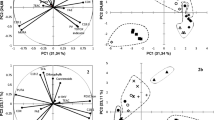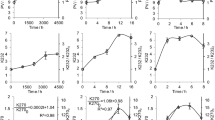Abstract
The effects of ascorbyl palmitate at 0, 300, 600, 900, or 1,200 ppm, tocopherol at 0, 200, 400, 600, or 800 ppm, and β-carotene at 0, 3, 6, 9, or 12 ppm on the oxidative stabilities of Oil 1, Oil 2, and Oil 3 containing 0, 0.55, and 0.67% of combined arachidonic acid (AA), docosapentaenoic acid (DPA), and docosahexaenoic acid (DHA), respectively, were studied by a central composite experimental design. The oxidative stability of oil was evaluated by determining the induction time using the Oxidative Stability Index. Ascorbyl palmitate and tocopherol had a significant effect on the stability of all three oils at α = 0.05. β-Carotene did not have any effect on the stability of oils at α = 0.05. The interaction effect of ascorbyl palmitate and tocopherol was significant for the three oils at α = 0.05. The induction time of oils decreased as the total amounts of AA, DPA and DHA increased from 0 to 0.55% or 0.55 to 0.67%. The addition of 1,200 ppm ascorbyl palmitate, 800 ppm tocopherol and 12 ppm β-carotene to Oils 1, 2, and 3 increased the induction time from 13.5 to 29.9 h, from 11.8 to 27.0 h, and from 10.5 to 20.0 h, respectively. The coefficient of determination (r 2) for the linear regression between the experimentally determined and statistically predicted induction time of the three oils was greater than 0.95. The use of an optimum combination of ascorbyl palmitate and tocopherols from the response surface analysis could improve the oxidative stabilities of oils containing AA, DPA and DHA.

Similar content being viewed by others
References
Fitch B (1993) Health implications of lipid oxidation. INFOM 4:803–809
Min DB, Lee HO (1999) Chemistry of lipid oxidation. In: Teranishi R, Wick FL, Hornstein I (eds) Flavor chemistry: thirty years of progress. Kluwer Plenum Publishers, New York, pp 175–187
Min DB, Boff JM (2001) Lipid oxidation of edible oil. In: Akoh CC, Min DB (eds) Food lipids, 2nd edn. Marcel Dekker, New York, pp 335–363
Frankel EN (1993) Search of better methods to evaluate natural antioxidants and oxidative stability in food lipids. Trends Food Sci Tech 4:220–225
Nawar W (1996) Lipids. In: Fennema OR (ed) Food chemistry, 3rd edn. Marcel Dekker, New York, pp 225–319
Frankel EN (1985) Chemistry of autoxidation: mechanism, products and flavor significance. In: Min DB, Smouse TH (eds) Flavor chemistry of fats and oils. AOCS Press, Champaign, pp 1–37
Miyashita K, Fujimoto K, Kaneda T (1982) Formation of dimers during the initial stage of autoxidation in methyl linoleate. Agric Biol Chem 46:751–756
Shahidi F, Wanasundara UN (2002) Methods for measuring oxidative rancidity in fats and oils. In: Akoh CC, Min DB (eds) Food lipids, 2nd edn. Marcel Dekker, New York, pp 465–488
O’Connor TP, O’Brien NM (1995) Lipid oxidation. In: PF Fox (ed) Advanced dairy chemistry, Vol 2—Lipids. Chapman & Hall, New York, pp 309–333
Pike OA (2002) Fat characterization. In: Nielsen SS (ed) Food analysis, 3rd edn. Kluwer Academic Plenum Publishers, New York, pp 227–246
Wan PJ (1995) Accelerated stability methods. In: Warner K, Eskins A (eds) Methods to assess quality and stability of oils and fat-containing foods. AOCS Press, Champaign, pp 179–187
Akoh CC (2002) Structure lipids. In: Akoh CC, Min DB (eds) Food lipids, 2nd edn. Marcel Dekker, New York, pp 877–885
Official methods and recommended practices of the AOCS, 5th edn. AOCS, Champaign, 1998
Hill SE, Perkins EG (1995) Determination of oxidative stability of soybean oil with the oxidative stability instrument: operation parameter effects. J Am Oil Chem Soc 72:741–743
Harris WS (1989) Fish oils and plasma lipid and lipoprotein metabolism in human: a critical review. J Lipid Res 30:785–809
Carlson SE (1994) The role of PUFA in infant nutrition. Int News Fats Oil Relat Mater 6:940–946
Durrington PN, Batnagar D, Mackness MI, Jorgan J, Julier K, Khan MA, France M (2001) An omega-3 polyunsaturated fatty acid concentrate administered for one year decreased triglycerides in Simvastin treated patients with coronary heart disease and persisting hypertriglyceridemia. Heart 85:544–548
Sardesai VM (1992) Nutritional role of polyunsaturated fatty acids. J Nutr Biochem 3:154–166
Passi S, Cataudella S, Marco PD, Simone FD, Rastrell L (2002) Fatty acid composition and antioxidant levels in muscle tissue of different Mediterranean marine species of fish and shellfish. J Agric Food Chem 50:7314–7322
Lee JH, Ozcelik B, Min DB (2003) Electron donation mechanisms of β-carotene as a free radical scavenger. J Food Sci 68:861–865
Myers RH, Montgomery DC (1995) Myers RH, Montgomery DC (eds) Response surface methodology: process and product optimization using designed experiments. Wiley, New York
Kris-Etherton P, Harris WS, Appel LJ (2002) Fish consumption, fish oil, omega-3 fatty acids, and cardiovascular disease. Am Heart Assoc Sci Statement 2747–2757
US Department of Health and Human Service (HHS), Dietary Guidelines for Americans. http://www.health.gov. Accessed Jan 2005
Jung MY, Min DB (1990) Effects of α-,γ-,and δ-tocopherols on oxidative stability of soybean oil. J Food Sci 55:1464–1465
Jeevarajan JA, Kispert LD (1996) Electrochemical oxidation of carotenoids containing donor/acceptor substituents. J Electroanalytic Chem 411:57–66
Choe E, Min DB (2005) Chemistry and reactions of reactive oxygen species in foods. J Food Sci 70:R142–159
Author information
Authors and Affiliations
Corresponding author
About this article
Cite this article
Bartee, S.D., Kim, H.J. & Min, D.B. Effects of Antioxidants on the Oxidative Stability of Oils Containing Arachidonic, Docosapentaenoic and Docosahexaenoic Acids. J Amer Oil Chem Soc 84, 363–368 (2007). https://doi.org/10.1007/s11746-007-1046-4
Received:
Accepted:
Published:
Issue Date:
DOI: https://doi.org/10.1007/s11746-007-1046-4




